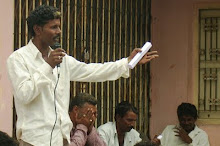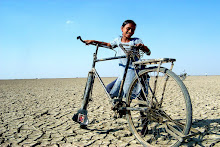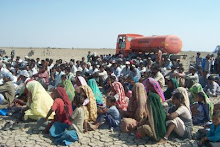Counterview:Thursday,September 29, 2011.
An authoritative study, conducted close on the heels of the Gujarat government’s move to displace thousands of salt pan workers, or agariyas, in the name of “preserving the Wild Ass Sanctuary” in the Little Rann of Kutch, has said that ignoring livelihood values of the Rann will be “counterproductive to both local development and well as wild ass conservation.”
Arguing in favour of a community based approach towards the governance of the Rann, instead of the current command-based one, to achieve “a balance between biodiversity conservation and livelihoods”, the study says that the Little Rann of Kutch as dry land and as wetland provides livelihood to traditional salt workers as well as farming communities. However, the communities equally play key role in wild-life conservation. Thus, ignoring livelihoods will prove counter-productive to both local development as well as wild ass conservation.
The study has been conducted by the Hyderabad-based Research Unit for Livelihoods and Natural Resources at the Centre for Economic and Social Studies (CESS) in collaboration with Agariya Heetrakshak Manch (AHRM) and Gujarat Vidyapeeth, Ahmedabad. The study is based on primary survey of both salt pan workers and farmers living in 108 villages Surendrangar, Patan, Kutch, Rakot districts of Gujarat in the periphery of the Rann.
No doubt, the farmers, as of today, suffer huge losses when the wild ass and other wild animals invade their fields along the Little Rann of Kutch. In fact, one of the major conclusions of the study is, an estimated crop loss to farmers along the periphery of Rann 48-50%. Even then, 75% of the farmers said there was a need to conserve the wild life. In fact, the farmers are willing to forego up to 12% of their production for the wild ass, blue bull and the wild boar.
In fact, as of today, 43.51% people say, they have to keep their agricultural land in a fallow state due to the danger of attacks from the wild life. However, this can be overcome, if the farmers, pastoralists, fishers and charcoal makers do not face livelihood threat “in terms of accessibility due to the present command and control method of wildlife conservation”, the study says.
As for the agariyas, who remain in the Rann for nearly six months in a year to produce salt on their small self-cultivating farms, the study admits that there may be a ”focussed interventions for betterment of salt workers through state and central government”. Yet, the fact is, a lot more needs to be done for over 12,000 families migrating to LRK every year for more than eight months. “The current interventions of water supply, health, education should be more community based and community monitored”, it underlines, pointing towards their inadequacy.
The study shows around 75.76 % of the traditional agariyas fall into deprived category when they are evaluated through 15 indicators such as food intake, health expenses, debt, land holding, fuel used, education status etc. “ Amongst 12,000 families 80.48% are landless and 79.46% of families have salt making is the only source of livelihood”, the study says.
Around 84.35% of the salt workers say that they have learnt salt making from their forefathers, which also supports the argument that it is traditional occupation of certain communities.
Only 3% of agariyas have passed higher secondary while 31% have reached primary, and 12% up to secondary.
During last season, an average price of salt given to agariya was 13.86 paisa per kg. Thus, any efforts for conservation of wild life with command and control approach, and ignoring the livelihood needs of the salt pan workers would be detrimental to them, the study underlines, adding, “Interdependency of wild life and community in Rann is unique. Uniqueness is the conservation cost born by community and their tolerance to forego up to 12% of their produce, which really needs appreciation. The statistics of the Gujarat Forest Department shows that the number of wild asses has been continuously increasing in last 30 years. It is co-existence model which needs formal recognition from the government.”
The study stresses that, “Ignoring livelihood value of the Little Rann of Kutch will be counter-productive to both development and wild ass conservation as it will harm relationship between the two.” Its authors quote Principal Chief Conservator of Forest (PCCF), and head of Forest department, Gujarat government, Pradeep Khanna, admitting that ”communities have contributed a lot in conservation of wild life in the Rann. We hope that the study will prove as first step towards the process of evolvement of balanced and comprehensive approach towards conservation of wild life and augmentation of livelihood.”


















.jpg)
.jpg)
.jpg)
.jpg)













No comments:
Post a Comment